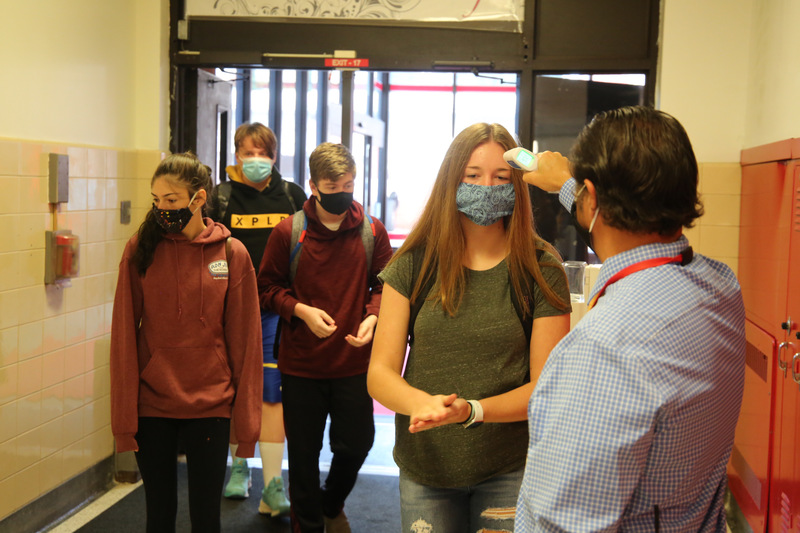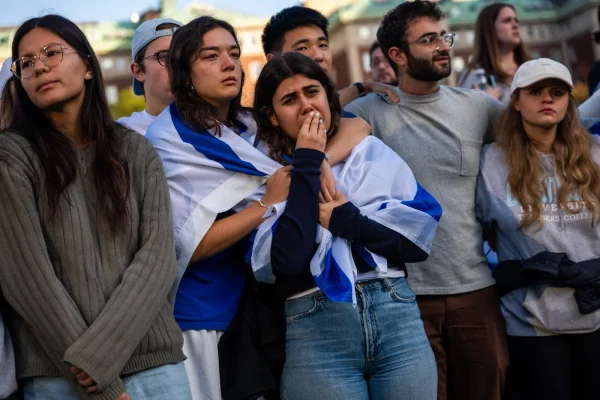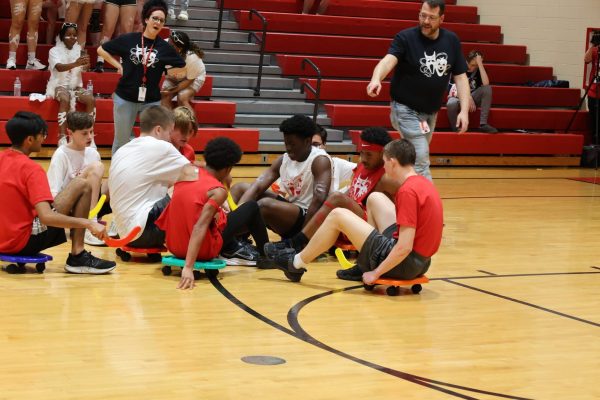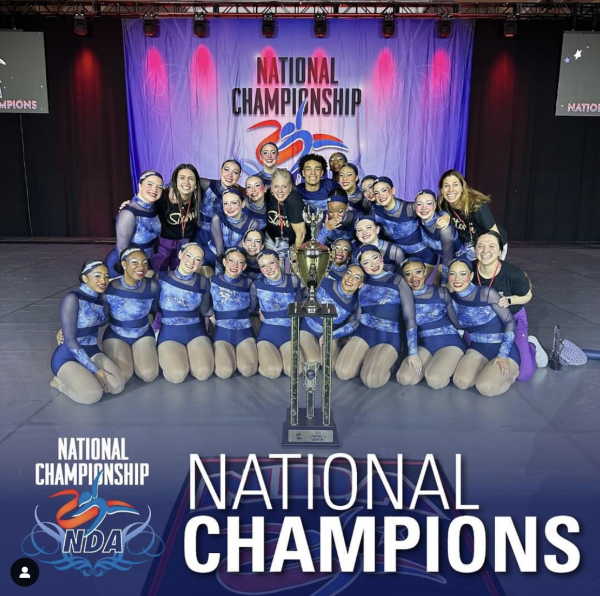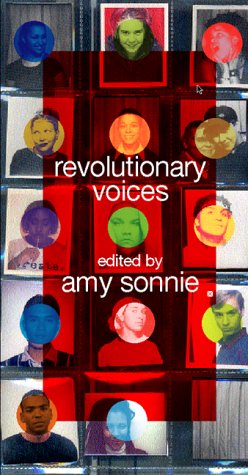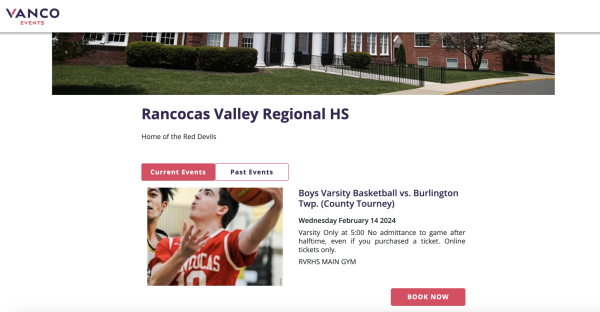Dystopian halls, bed-to-laptop crawls and playing it by ear
How does RV’s hybrid schedule compare to other schools in the area?
More stories from Sara Terwilliger
Photo courtesy of Mr. Maniglia
Student temperatures are taken at entryways around school, as part of RV’s hybrid learning plan
Take a seat, hope that it has been immaculately wiped down with an unbranded disinfectant wipe, and get ready to be disappointed that even if you move to another NJ school, where you will still be dealing with similar nerves and scheduling.
RV’s hybrid schedule has become a normalcy for students and teachers alike, but other New Jersey schools have been following their own learning cycles, for better or for worse. Four months into the 2020-2021 school year, nearby schools and students are familiar, but continue to sit on the edge of their seats, prepared to morph plans in accordance with the pandemic. Hearing from students around South Jersey, RV can be comforted with the knowledge that other schools in the area are feeling just as uneasy and inclined to the ‘let’s play it by ear’ concept.
The Red Devils’ schedule has stayed decently consistent since the beginning of the school year, save for some week-long closures due to an influx of cases. Sorted by last names into cohorts A-D due to the size of RV’s population (almost 2,100), a different cohort goes into the building on a different day of the week, besides Wednesday which remains all virtual. Those who are not in said cohort day remain virtual, as well as those who have decided for all virtual instruction. First block/homeroom begins at 7:44am, each block of the day is about 50 minutes, including a lunch/prep break, and the last block of the day ends around 12:30- a schedule similar to the half day schedule of previous years.
“It doesn’t matter if I am in school or home, my motivation is gone,” RV senior Jacey Matthews said about her experience with the hybrid schedule. “I’m staying home now because of rising cases, and assignments keep piling up and everything feels pointless. But when I did go to school, I felt relatively uncomfortable, not because of cleaning efforts, but because despite the precautions everyone still crowded the hallways and exits.”
Matthews, like many other students, struggled with deciding which path to take, based on what would be best for her own education, safety of her family and mental health.
“Emotionally, walking down the halls reminded me of some empty, dystopian horror,” Matthews said. “In-person really bummed me out, reminding me of how awful senior year is compared to others.”
As students in RV question the worthiness of hearing shoes tap through empty halls versus a lack of motivation and control at home, other schools in the area have much different expectations and experiences.
Joseph Feliciano, a junior at Moorestown High School, explained how the school district has handled opening, and his and his fellow students’ reactions.
“We have about 2,000 students enrolled here, so we had to spread it out like [RV] did,” Feliciano said. “In September, we started off on a hybrid schedule, separated by last name into two cohorts, black and yellow for the school colors. Each group would switch going every other day, while the other group was home virtually. Our new schedule is not much different than what it used to be, we still have 12 blocks in a day, some are study halls or rest periods, except between 6th and 7th block and 8th and 9th block the class goes back and forth with the days. Each class is maybe 40 minutes which is pretty easy, and we get out a little after 12 most days.”
Compared to RV’s regular classes, there are nearly double the amount in comparison, even in past years. But since this is the normal for Moorestown students, many are unfazed, even with all virtual learning taking over.
“We have a few cases pop up in late November,” Feliciano said, “They said we’d be back December 8th, but then they reevaluated and decided that they will not be bringing us back until sometime in January. It makes sense though, I went in a few times at the beginning of the year and I never felt comfortable with so many people around. That’s why I eventually went all virtual. That’s a struggle too though, having to travel from bed to the office is even a struggle, it’s exhausting either way.”
When asked if he thought that the schedule of students coming in could have contributed to the cases, Feliciano responded, “People hype up MHS for being one of the best schools in the area, but in comparison to other schools right now, we’re making mistakes, and that’s pretty average in itself.”
School pride in itself is often not enough to keep students from feeling uneasy in their decisions this year, especially as cases go up and each school’s schedules are either experimental or too similar to in person school to be comfortable when cases rise.
Senior Daniel Katz-Heineken, who is enrolled in Collingswood High School, shared his involvement in the school’s schedule planning. “For right now we have a hybrid schedule, just like just about everyone else,” Katz-Heineken said. “There are somewhere around 750 students, and we are separated into Gold and Blue, the school colors. I’m blue so I go on Monday and Tuesday, Wednesday everyone is at home, and gold goes on Thursday and Friday. Our schedule is confusing and busy, but most of us find it pretty easy now. Buckle up. Monday and Tuesday we have only our first four periods, of ‘the day’, Thursday and Friday you do the last four periods, and Wednesday you attend all eight. Most of the week each class is 45 minutes long, but on Wednesdays it’s really a 20 minute check in. Trust me, it’s easier than the constant rotation schedule it used to be. I helped plan it, since my mom works in the main office, and they use me for inside information. Their practical guinea pig.”
In comparison to Rancocas Valley, nearby schools tend to have a much more complicated schedule, but seem to have found the new hours and classes easier. As schools adjust to the hybrid schedule, student resources reach out to those who are having trouble adjusting or are generally struggling.
“I have found it pretty easy to complete my classes in and out of the building,” Katz-Heineken said. “I have no problems being there either; there’s not enough of us to really worry about, we try to have class outside as much as possible, and though there are some a***oles who pull down their masks, most of us attack them about it. Plus there’s a big focus on mental health here, so the teachers and counselors really support anyone if they feel uneasy.”
Despite schedule changes and stressors, a large portion of students are adjusting well, and have decided to attend in-person classes rather than staying online.
“We haven’t had a large amount of cases as far as I know, maybe three and those were controlled fast, so we haven’t had to go all virtual yet,” Katz-Heineken said. “Hopefully it will stay that way, and it means that we’re doing something right.”
Other schools, and their complicated schedules, have had a multitude of results based on school support, case numbers, and school population as well as other factors. As 2020 comes to a close, and the second semester nears, students across New Jersey and the country wait to see possible new changes to their schedules and high school plans based around them.
Best encompassed by Matthews once more, “It’s really needed that we stay receptive as to what other schools are up to so we can figure out what works and what doesn’t. Even though some of it doesn’t seem worth the risk, we’re all doing our best here, and whatever changes come, hopefully it’ll be for the better.”
Your donation will support the student journalists of Rancocas Valley Regional High School. Your contribution will allow us to enter into regional and national competitions, and will help fund trips to journalism conferences to continue to improve our writing and work!

